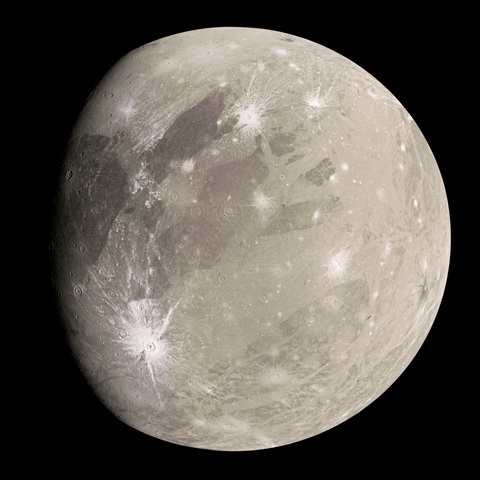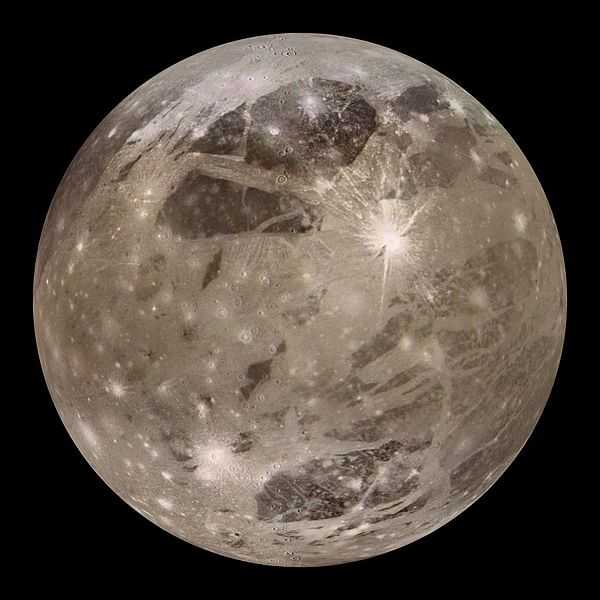Ganymede, a satellite of Jupiter, is the largest and most massive of the Solar System’s moons. The ninth-largest object of the Solar System, it is the largest without a substantial atmosphere.
View on Maps: google.com/maps/space/ganymede
Radius: 2,634.1 km
Gravity: 1.428 m/s²
Orbital period: 172 hours
Discovered: 7 January 1610
Age: 4.503 billion years
Density: 1.94 g/cm³
List of facts
Ganymede is a satellite of Jupiter
Ganymede is also known as Jupiter III
Ganymede is the largest and most massive of the Solar System’s moons.
It has a diameter of 5,268 km
Ganymede orbits Jupiter in roughly seven days
Ganymede’s discovery is credited to Galileo Galilei, the first to observe it, on January 7, 1610
Its name was soon suggested by astronomer Simon Marius, after the mythological Ganymede, a Trojan prince desired by Zeus
Ganymede has a thin oxygen atmosphere that includes O, O2, and possibly O3 (ozone).
Ganymede’s magnetic field is probably created by convection within its liquid iron core, also created by Jupiter’s tidal forces
Ganymede is composed of approximately equal amounts of silicate rock and water.
Ganymede orbits Jupiter at a distance of 1,070,400 kilometres, third among the Galilean satellites
Ganymede is tidally locked, with one side always facing toward the planet
Ganymede completes a revolution every seven days and three hours
Ganymede participates in orbital resonances with Europa and Io: for every orbit of Ganymede, Europa orbits twice and Io orbits four times

Ganymede is more than twice as massive as the Earth’s Moon.
Ganymede is the ninth-largest object in the solar system, but the tenth-most massive.
It was probably formed by an accretion in Jupiter’s subnebula, a disk of gas and dust surrounding Jupiter after its formation.
Ganymede is larger than the planet Mercury, which has a diameter of 4,880 kilometres
The average density of Ganymede, 1.936 g/cm3, suggests a composition of about equal parts rocky material and mostly water ices
Some of the water is liquid, forming an underground ocean
In 2021 water vapour was detected in the atmosphere of Ganymede
The daytime temperatures on the surface of Ganymede range from minus 171 degrees Fahrenheit to minus 297 degrees Fahrenheit
The Jupiter Icy Moons Explorer (JUICE) will be the first to enter orbit around Ganymede itself
Several spacecraft have performed close flybys of Ganymede: two Pioneer and two Voyager spacecraft made a single flyby each between 1973 and 1979
the Galileo spacecraft made six passes between 1996 and 2000
the Juno spacecraft performed two flybys in 2019 and 2021
Ganymede’s grooves can be as high as 2,000 ft and stretch for thousands of miles. They were formed by tectonic activity and water being released from below the surface.

40% of Ganymede’s surface is covered with highly cratered dark regions that are believed to be from heavy impact by comets and asteroids that date back to around 4 billion years ago.
Ganymede is the only moon in the solar system known to have a substantial magnetosphere
Ganymede was likely formed in place around the young Jupiter in the early Solar System.
The moon has polar caps, possibly caused by ice interacting with plasma being funnelled down its magnetic field and creating a layer of frost.
It has an internal ocean which could hold more water than all of planet Earths oceans combined.
The average speed of Ganymede as it orbits Jupiter is 10.880 km/s.
Ganymede information
Discovery |
|||||||||||||
|---|---|---|---|---|---|---|---|---|---|---|---|---|---|
| Discovered by | Galileo Galilei | ||||||||||||
| Discovery date | January 7, 1610 | ||||||||||||
| Designations | |||||||||||||
|
Named after
|
Γανυμήδης, Ganymēdēs | ||||||||||||
|
Alternative names
|
Jupiter III | ||||||||||||
| Adjectives | Ganymedian,Ganymedean | ||||||||||||
Orbital characteristics |
|||||||||||||
| Periapsis | 1069200 km | ||||||||||||
| Apoapsis | 1071600 km | ||||||||||||
|
Semi-major axis
|
1070400 km | ||||||||||||
| Eccentricity | 0.0013 | ||||||||||||
|
Orbital period (sidereal)
|
7.15455296 d | ||||||||||||
|
Average orbital speed
|
10.880 km/s | ||||||||||||
| Inclination | 2.214° (to the ecliptic) 0.20° (to Jupiter’s equator) |
||||||||||||
| Satellite of | Jupiter | ||||||||||||
| Group | Galilean moon | ||||||||||||
Physical characteristics |
|||||||||||||
|
Mean radius
|
2634.1±0.3 km (0.413 Earths) | ||||||||||||
|
Surface area
|
8.72×107 km2 (0.171 Earths) | ||||||||||||
| Volume | 7.66×1010 km3 (0.0704 Earths) | ||||||||||||
| Mass | 1.4819×1023 kg (0.025 Earths)(2.02 Moon’s) (0.23 Mars’) | ||||||||||||
|
Mean density
|
1.936 g/cm3 (0.351 Earths) | ||||||||||||
|
Surface gravity
|
1.428 m/s2 (0.146 g) | ||||||||||||
|
Moment of inertia factor
|
0.3115±0.0028 | ||||||||||||
|
Escape velocity
|
2.741 km/s | ||||||||||||
|
Synodic rotation period
|
synchronous | ||||||||||||
|
Axial tilt
|
0–0.33° | ||||||||||||
| Albedo | 0.43±0.02 | ||||||||||||
|
|||||||||||||
|
Apparent magnitude
|
4.61 (opposition) 4.38 (in 1951) |
||||||||||||
|
Angular diameter
|
1.2 to 1.8 arcseconds | ||||||||||||
Atmosphere |
|||||||||||||
|
Surface pressure
|
0.2–1.2 μPa (1.97×10−12–1.18×10−11 atm) | ||||||||||||
| Composition by volume | |||||||||||||
